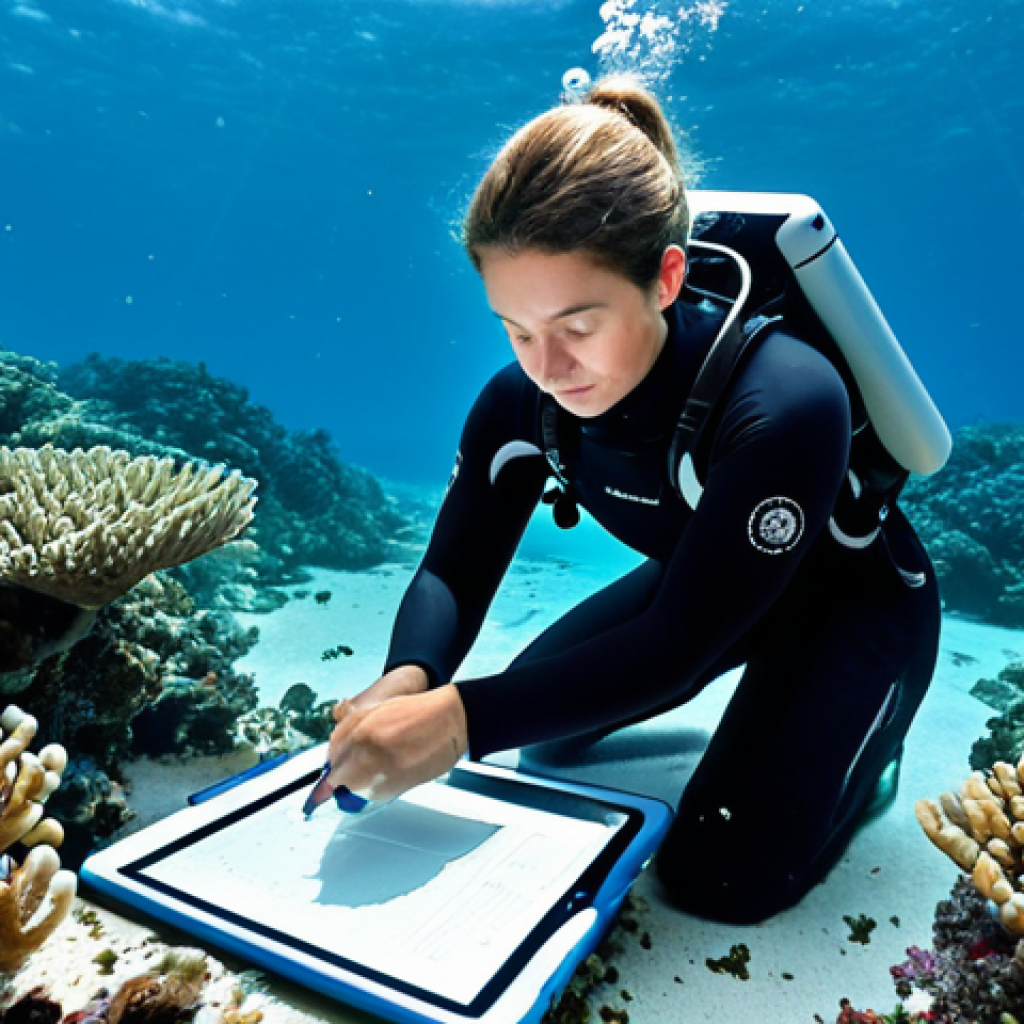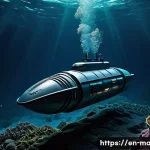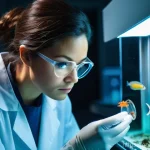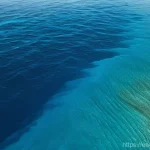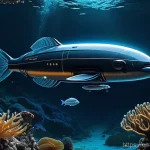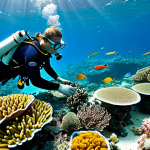The ocean, that vast, shimmering expanse, has always captivated me. I still remember my first time snorkeling over a vibrant coral reef; the kaleidoscope of colors and the sheer bustling life beneath the waves felt like stepping into an alien world.
Yet, this breathtaking beauty, the very heart of our planet’s life support, is under unprecedented strain. From the insidious creep of microplastics, which I’ve personally found in the sand far from any city, to the profound changes brought by rising ocean temperatures that are silently bleaching our irreplaceable reefs, these are challenges demanding our immediate attention.
Experts are now grappling with how global heating impacts marine currents and food chains, predicting shifts that could reshape entire ecosystems. But amidst this urgency, there’s a powerful current of innovation: from AI-driven data analysis identifying vulnerable species to groundbreaking robotics designed for deep-sea restoration, humanity is beginning to leverage cutting-edge tech.
The future of our marine environments hinges on our collective understanding and action. It’s a complex tapestry of wonder, crisis, and burgeoning solutions.
Let’s dive deeper into it below.
The Silent Crisis Beneath the Shimmering Surface
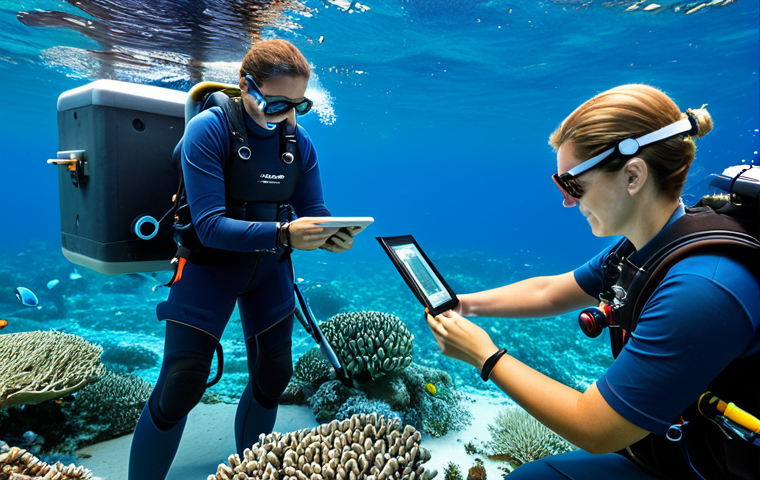
It’s easy to look at the vast expanse of the ocean and assume its problems are too enormous or too distant to affect us. But having spent years exploring coastal areas, from bustling harbors to secluded coves, I’ve started to see the insidious signs of a crisis that’s anything but distant.
I vividly recall a particular afternoon walk along a seemingly pristine beach, far from any major city, only to find countless tiny, colorful fragments of plastic meticulously woven into the sand.
It felt like a punch to the gut, a stark reminder that our human footprint reaches everywhere, even into the most remote corners of nature. This wasn’t just litter; these were microplastics, the almost invisible remnants of our consumer habits, making their way into the very building blocks of marine life.
And it’s not just plastics. The vibrant coral reefs I once snorkeled over, teeming with life and bursting with color, now sometimes resemble ghostly underwater cemeteries, bleached white by rising ocean temperatures.
This isn’t just a loss of beauty; it’s a systemic breakdown, impacting everything from fish populations that feed millions to the very air we breathe.
We’re witnessing an unprecedented assault on the ocean’s delicate balance, and understanding these threats is the first crucial step towards healing.
1. Microplastics: An Invisible Threat We’ve Created
For me, the issue of microplastics isn’t theoretical; it’s something I’ve personally encountered. These tiny fragments, less than 5 millimeters long, originate from larger plastic debris that breaks down, synthetic fibers from clothing, or even microbeads in personal care products.
They’re so small that they can bypass water filtration systems and end up in rivers, lakes, and ultimately, the ocean. Once there, they’re ingested by marine organisms, from the smallest plankton to the largest whales, moving up the food chain, potentially bringing harmful chemicals with them.
The thought that every piece of seafood I’ve eaten might contain these plastic particles is unsettling, and it’s a stark reminder of our collective responsibility to rethink our consumption habits and waste management strategies.
This isn’t a problem that will simply wash away; it demands a proactive, global response.
2. Coral Reefs: The Ocean’s Fading Masterpieces
There’s truly nothing like diving into a healthy coral reef. The explosion of color, the dizzying array of fish, the sheer vibrant energy of it all – it’s an immersive, almost spiritual experience.
That’s why witnessing coral bleaching first-hand is so profoundly disheartening. When ocean temperatures rise, corals expel the symbiotic algae living in their tissues, turning white and becoming vulnerable to disease and death.
It’s a tragedy unfolding globally, with some of the world’s most iconic reefs suffering catastrophic losses. These “rainforests of the sea” are not just beautiful; they support a quarter of all marine species, protect coastlines from storms, and underpin significant tourism and fishing industries.
Losing them means losing irreplaceable biodiversity, essential coastal protection, and vital economic lifelines for countless communities.
3. Ocean Acidification: A Silent Chemical Shift
Beyond the visible threats, a more insidious change is taking place: ocean acidification. As the ocean absorbs increasing amounts of carbon dioxide from the atmosphere, its chemistry changes, becoming more acidic.
From my perspective, this isn’t as visually dramatic as a bleached reef, but its long-term implications are terrifying. This shift makes it harder for marine organisms like oysters, clams, and corals to build their shells and skeletons, literally dissolving their homes.
Imagine trying to build a house when your bricks are constantly eroding – that’s the reality for these creatures. This fundamental change in ocean chemistry could disrupt entire food webs, affecting everything from commercial fisheries to the very base of the marine ecosystem.
Leveraging Technology to Become the Ocean’s Ally
For a long time, the scale of ocean problems felt overwhelming, almost insurmountable. But what truly gives me hope, and what I believe is critical for our success, is the rapid advancement of technology.
We’re no longer just passively observing the decline; we’re actively using cutting-edge tools to understand, monitor, and even restore our marine environments.
It’s a shift from despair to determined action, and frankly, it feels like science fiction becoming reality right before our eyes. From autonomous underwater vehicles that map uncharted depths to AI algorithms that can predict marine heatwaves, these innovations are equipping us with unprecedented capabilities.
The beauty of it is that this isn’t just about big government projects; it’s about smart, agile solutions that can be deployed rapidly and scaled effectively.
The integration of data science with marine biology is transforming our approach, moving us from reactive measures to proactive conservation, and that’s something genuinely exciting to witness.
| Technology Type | Primary Application | Key Benefit | Personal Impact/Observation |
|---|---|---|---|
| AI & Machine Learning | Species tracking, pollution detection, predictive modeling | Rapid data analysis, early warning systems for ecological shifts | “I’ve seen articles showing how quickly AI can pinpoint endangered turtle nesting sites, a level of efficiency humans alone couldn’t achieve.” |
| Robotics (AUVs/ROVs) | Reef restoration, deep-sea exploration, data collection in hazardous areas | Access to inaccessible areas, precision in intervention and mapping | “Watching videos of those underwater robots meticulously planting coral fragments feels like witnessing sci-fi becoming a hopeful reality.” |
| Satellite Monitoring | Ocean temperature tracking, illegal fishing detection, habitat mapping at scale | Large-scale, consistent data collection and real-time insights | “It’s incredible to think satellites can spot changes like massive algal blooms or illegal fishing vessels that are invisible to the naked eye from land.” |
| Biotechnology | Coral genetic research, bioremediation of oil spills, developing resilient species | Disease resistance, accelerating natural restoration processes, innovative clean-up | “The potential for developing ‘super corals’ that can withstand warmer waters gives me so much profound hope for the future of our reefs.” |
1. AI’s Predictive Power in Marine Biology
Artificial intelligence isn’t just for predicting stock markets or recommending movies; it’s revolutionizing how we understand and protect marine life.
I’ve been fascinated by how AI is being used to analyze vast datasets from underwater sensors, satellite imagery, and even acoustic recordings. For example, AI can identify individual whales by their calls, track migration patterns with astonishing accuracy, or even detect the presence of plastic pollution in water bodies far more efficiently than human analysis ever could.
It’s like having a super-powered assistant that can sift through mountains of information to pinpoint critical threats or vulnerable populations, giving conservationists a vital head start.
This predictive capability allows us to intervene *before* a crisis escalates, rather than simply reacting to disaster, which, from my experience, is a far more effective approach.
2. Underwater Robotics: Our Hands in the Deep
There are parts of the ocean that are more alien than outer space, and for a long time, they remained largely unexplored. Now, with sophisticated underwater robotics – from autonomous underwater vehicles (AUVs) to remotely operated vehicles (ROVs) – we’re finally gaining access.
I find the images and data these machines send back absolutely breathtaking. They’re mapping the seafloor with incredible precision, monitoring deep-sea vents, and even identifying new species.
But it’s not just about exploration; these robots are becoming crucial tools for restoration. Imagine robots precisely planting coral fragments on damaged reefs or monitoring the health of fragile deep-sea ecosystems without disturbing them.
They can operate in conditions too dangerous or too deep for humans, extending our reach and giving us a physical presence in the battle for ocean health.
3. Satellite Sentinel: Watching from Above
Sometimes the biggest picture gives us the clearest understanding. Satellite monitoring, while perhaps less ‘glamorous’ than deep-sea robots, offers an invaluable bird’s-eye view of our oceans.
I often check publicly available satellite maps to track ocean temperatures or even get a sense of sea ice coverage, and it’s truly powerful to see the global scale of changes.
Satellites can detect illegal fishing activities, track oil spills, monitor algal blooms, and even measure minute changes in sea level that indicate shifts in climate patterns.
This continuous, large-scale data collection provides policymakers and scientists with crucial evidence to inform conservation strategies and enforce regulations, giving us the holistic perspective needed to address a problem as vast as the ocean itself.
Rebuilding Ocean Ecosystems: A Hands-On Approach to Hope
While understanding the threats and deploying technology is vital, what truly ignites my passion for ocean conservation is seeing tangible efforts to restore what’s been lost.
It’s not enough to simply stop the damage; we must actively heal. There’s something incredibly hopeful about watching scientists and volunteers meticulously work to bring life back to a degraded area.
I’ve seen projects where tiny coral fragments are nurtured in underwater nurseries before being carefully replanted onto damaged reefs, and the thought of these efforts blossoming into vibrant new ecosystems fills me with profound optimism.
This hands-on, often painstaking work reminds me that even though the challenges are immense, human ingenuity and dedication can make a real difference, piece by piece, organism by organism.
It’s a testament to our capacity for stewardship, transforming barren underwater landscapes back into thriving havens of biodiversity.
1. Cultivating New Coral Colonies
One of the most inspiring restoration efforts I follow involves coral propagation. It’s a bit like gardening, but underwater and with far higher stakes.
Scientists and volunteers collect fragments from healthy corals – or sometimes from corals of opportunity, naturally broken pieces – and attach them to artificial structures or directly to degraded reefs.
These ‘coral nurseries’ allow the fragments to grow in a protected environment before being outplanted. Seeing the tiny polyps slowly begin to grow, re-establishing themselves on a formerly desolate patch of reef, is an incredibly moving experience.
It’s a slow process, but it’s a direct intervention that provides a lifeline for these critical ecosystems, offering a beacon of hope where once there was only decline.
2. The Resurgence of Kelp Forests
Beyond corals, kelp forests are another vital, often overlooked, marine habitat. These towering underwater forests provide food and shelter for countless species, from tiny invertebrates to sea otters and gray whales.
They’re also incredible carbon sinks. However, they’ve faced significant declines due to warming waters and overgrazing by sea urchins. Thankfully, active restoration efforts are bringing them back.
This includes transplanting kelp, reducing urchin populations (sometimes even with “urchinomics” where urchins are harvested for food), and creating optimal conditions for kelp regrowth.
Witnessing even small patches of new kelp begin to sway in the current fills me with a deep sense of satisfaction, knowing that a whole ecosystem is being invited to return and thrive.
3. Marine Protected Areas: Sanctuaries of Hope
While direct intervention is powerful, sometimes the best solution is simply to leave nature alone to heal. Marine Protected Areas (MPAs) are designated zones where human activities, particularly fishing and development, are restricted or prohibited.
From my perspective, these are crucial sanctuaries. They allow fish populations to recover, habitats to regenerate, and biodiversity to flourish, creating spillover effects that benefit surrounding areas.
It’s like setting aside a wild garden and letting it bloom naturally. The success stories from well-managed MPAs around the world are truly inspiring, demonstrating that when we give the ocean space and time, its resilience is truly remarkable.
The Ripple Effect: Why a Healthy Ocean Matters to Us All
It’s easy to feel disconnected from the ocean if you don’t live near it, but I assure you, its health impacts every single one of us, no matter where we are.
From the air we breathe to the food on our plates, the ocean plays an indispensable role in maintaining our planet’s life support systems. It’s not just a vast blue space; it’s a dynamic engine, regulating climate, providing sustenance, and underpinning global economies.
When I think about the sheer volume of oxygen produced by marine phytoplankton – roughly half of all the oxygen on Earth – it’s a mind-boggling realization.
This isn’t just about saving exotic species; it’s about safeguarding our own future, our economy, and our quality of life. The connections are far more intricate and profound than most people realize, making ocean conservation a truly universal imperative.
1. The Blue Economy: More Than Just Fish
The ocean isn’t just a pretty backdrop for vacations; it’s a massive economic engine. Fisheries, aquaculture, tourism, shipping, energy production – these industries contribute trillions of dollars to the global economy and support hundreds of millions of jobs.
From my experience, understanding this economic dimension is critical for convincing stakeholders to invest in conservation. When reefs bleach, tourism suffers.
When fish stocks collapse, livelihoods vanish. Conversely, a healthy ocean can provide sustainable resources and generate immense wealth, creating a “blue economy” that benefits everyone.
It’s about recognizing that ecological health and economic prosperity are not mutually exclusive but deeply intertwined.
2. The Ocean’s Role in Climate Regulation
We often talk about forests as the “lungs of the Earth,” but the ocean plays an equally, if not more, critical role in regulating our climate. It absorbs a huge percentage of the excess heat and carbon dioxide we produce, acting as a massive buffer against climate change.
I often reflect on how much worse our climate situation would be without the ocean’s tireless work. However, this absorption comes at a cost, leading to the warming and acidification we discussed earlier.
Protecting the ocean is, therefore, a frontline defense against global warming, ensuring that this vital climate regulator can continue to perform its essential functions for generations to come.
3. Impacts on Coastal Communities and Beyond
For coastal communities, the ocean isn’t just a resource; it’s home, culture, and identity. When I visit these communities, I see firsthand how intimately their lives are tied to the sea.
They are also the first to feel the brunt of ocean degradation – rising sea levels, increased storm surges due to degraded coastal habitats, and dwindling fish catches.
But the impact doesn’t stop at the shore. Disrupted shipping lanes affect global trade, and changes in ocean currents can alter weather patterns far inland.
The health of the ocean truly creates a ripple effect that touches every corner of the globe, making its protection a responsibility we all share.
Empowering Change: From Policy to Personal Action
When faced with a challenge as monumental as ocean conservation, it’s easy to feel helpless. But from my vantage point, the most powerful force for change often starts at the individual level, radiating outwards to influence policy and inspire collective action.
I’ve personally tried to reduce my plastic consumption and make more sustainable seafood choices, and while it feels small, these actions cumulatively create significant impact.
It’s about recognizing that every single choice we make, from what we buy to how we vote, sends a signal. This isn’t just about governmental decrees; it’s about a groundswell of public awareness and demand for change that ultimately shapes legislation and corporate practices.
The shift in public perception and the growing demand for sustainable products truly gives me immense hope that our collective voices can turn the tide.
1. Shaping Policy for a Sustainable Future
While individual actions are crucial, systemic change often requires robust policy and international cooperation. I’ve followed with great interest the negotiations around global plastics treaties and the expansion of marine protected areas.
These large-scale agreements and national policies are essential for setting binding targets, enforcing regulations against illegal fishing, and investing in sustainable infrastructure.
It’s a slow, often frustrating process, but effective policy provides the framework within which significant progress can be made. Advocating for strong environmental policies and holding our leaders accountable is a powerful way to contribute to ocean health.
2. Consumer Choices: Our Daily Vote for the Ocean
Every time we make a purchase, we’re casting a vote for the kind of world we want to live in. For me, this translates to actively seeking out sustainable seafood certifications, choosing products with minimal plastic packaging, and supporting companies that demonstrate a genuine commitment to environmental responsibility.
It’s not always easy, and sometimes the “sustainable” option is more expensive, but the long-term benefit for the planet is immeasurable. Our collective purchasing power sends a clear message to industries that consumers demand environmentally friendly practices, driving innovation and responsible production.
3. The Rising Tide of Citizen Scientists
One of the most inspiring trends I’ve witnessed is the rise of citizen science. Everyday people, equipped with nothing more than a smartphone or a dive mask, are contributing valuable data to scientific research.
From reporting marine debris on beach cleanups to identifying marine species in online databases, these efforts are expanding our collective knowledge and surveillance capabilities exponentially.
It empowers individuals to become active participants in conservation, fostering a deeper connection to the ocean and providing scientists with invaluable, large-scale datasets that would be impossible to collect otherwise.
It’s a truly democratic approach to environmental protection, and it makes me feel like anyone can contribute.
Innovating for a Brighter Blue Future: Beyond Today’s Challenges
Looking ahead, the potential for innovation to address ocean challenges is truly thrilling. While current issues demand immediate attention, I find myself captivated by the groundbreaking research and development happening globally, which promises to reshape our relationship with the marine environment.
It’s not just about fixing past mistakes; it’s about designing a future where humanity and the ocean can thrive in harmony. From developing materials that could revolutionize how we package goods to harnessing the ocean’s vast energy potential, the ingenuity is boundless.
This forward-looking perspective, fueled by scientific curiosity and a deep sense of responsibility, is what makes me genuinely optimistic about the future of our blue planet, recognizing that the solutions we envision today will become the realities of tomorrow.
1. Revolutionary Materials: Plastic Alternatives
The plastic pollution crisis is overwhelming, but the human drive to innovate is relentless. I’m incredibly excited by the development of truly biodegradable plastics, packaging made from seaweed, or even mycelium (mushroom-based) materials that can replace conventional plastics.
Imagine a world where all packaging naturally decomposes and feeds the environment instead of polluting it for centuries. These aren’t just niche products; they represent a fundamental shift in material science and manufacturing, offering viable, scalable alternatives to our reliance on fossil fuel-derived plastics.
It’s a game-changer that could drastically reduce the flow of waste into our oceans.
2. Harnessing Ocean Energy: A Clean Power Source
The ocean is a powerhouse of untapped renewable energy. Tidal power, wave energy, and even ocean thermal energy conversion (OTEC) offer immense potential for clean, sustainable electricity generation.
I’m fascinated by the engineering challenges and opportunities presented by these technologies. Tapping into the ocean’s natural movements can provide a consistent, predictable energy source, reducing our reliance on fossil fuels and consequently mitigating the climate change that impacts the ocean itself.
While still in nascent stages for large-scale deployment, I believe ocean energy will play a significant role in our future global energy mix, creating a powerful synergy between energy independence and environmental stewardship.
3. Advanced Waste Management Technologies
Beyond simply finding alternatives to plastics, innovations in waste management are crucial. This includes advanced recycling techniques that can process mixed plastics more efficiently, technologies that can convert waste into energy, and even new approaches to capturing plastic before it ever reaches the ocean.
I’ve seen prototypes of river barriers designed to collect plastic closer to urban sources, and drones that can survey remote coastlines for debris. These smart, proactive solutions address the problem at various points in the waste stream, offering a multi-pronged approach to keeping our oceans clean.
It’s about moving beyond simply “reducing, reusing, recycling” to fundamentally reimagining how we manage the waste our societies produce.
Closing Thoughts
The journey to healing our oceans is vast and complex, but as I reflect on the incredible innovations and dedicated individuals I’ve encountered, I feel a profound sense of optimism.
It’s clear that humanity’s ingenuity, coupled with a deep respect for our planet, holds the key to a thriving blue future. Every action, big or small, contributes to the ripple effect of positive change.
Let’s continue to be the voice for our oceans, ensuring they remain vibrant sources of life, beauty, and sustenance for generations to come.
Useful Information to Know
1. Check Your Seafood Choices: Utilize resources like the Monterey Bay Aquarium Seafood Watch guide (available online and as an app) to make informed, sustainable seafood choices. This helps support healthy fish populations and responsible fishing practices.
2. Reduce Single-Use Plastics: Start small by carrying a reusable water bottle, coffee cup, and shopping bags. These simple changes significantly reduce plastic waste that often ends up in our oceans and other natural environments.
3. Support Ocean Conservation Organizations: Consider donating to or volunteering with reputable organizations dedicated to marine research, advocacy, and direct conservation efforts. Your support fuels critical work on the ground and in policy arenas.
4. Understand Blue Carbon: Learn about the power of coastal ecosystems like mangroves, salt marshes, and seagrass beds to absorb and store carbon. Protecting these vital habitats is crucial for climate mitigation and overall ocean health.
5. Be an Advocate: Your voice matters. Contact your elected officials to express your support for strong ocean protection policies, participate in local cleanups, and share what you learn with friends and family to spread awareness.
Key Takeaways
The ocean faces critical threats from microplastics, coral bleaching, and acidification, yet technological advancements like AI, robotics, and satellite monitoring are empowering unprecedented conservation efforts. Active restoration initiatives, including coral propagation and kelp forest regrowth, alongside the establishment of Marine Protected Areas, offer tangible hope for ecosystem recovery. A healthy ocean is indispensable for global climate regulation, economic stability, and the well-being of coastal communities and beyond. Empowering change requires a multi-faceted approach, combining impactful policy, conscious consumer choices, and the growing involvement of citizen scientists, all driving towards a future where innovation and responsibility safeguard our invaluable blue planet.
Frequently Asked Questions (FAQ) 📖
Q: You mentioned personally finding microplastics and seeing the impact of rising temperatures. From your perspective, what are the most immediate and tangible threats facing our oceans that everyday people might not fully grasp?
A: Oh, that’s a question that honestly keeps me up at night. Beyond the sheer tragedy of seeing bleached reefs firsthand – it’s like watching a vibrant city slowly die, and it tears at your heart – what really hits home for me is the insidious nature of microplastics.
I mean, I was on a seemingly pristine beach, miles from any major city, just walking along, and there it was: tiny, almost invisible flecks of plastic mixed right into the sand.
It makes you realize just how pervasive this problem is, how it’s literally woven into the fabric of our natural world, even in places you’d never expect.
And then there’s the ‘silent killer,’ ocean warming. It’s not just about a few degrees; it’s about disrupting delicate balances that have existed for millennia, impacting everything from the smallest plankton to the largest whales by shifting currents and food sources.
These aren’t abstract concepts; they’re happening right now, subtly yet profoundly altering the very lifeblood of our planet, and we need to feel that urgency.
Q: It sounds like a grim picture, but you also mentioned “a powerful current of innovation.” How are these new technologies, like
A: I and robotics, really making a difference on the ground for marine conservation? A2: You know, it’s easy to feel overwhelmed, but that’s where the innovation truly becomes a beacon of hope.
I’ve seen some incredible things happening. Take AI, for instance: it’s not just some buzzword; it’s being deployed to analyze vast datasets from underwater sensors, helping us pinpoint exactly where vulnerable species are, or even predict harmful algal blooms before they devastate an area.
It’s like having an incredibly intelligent, tireless assistant that can see patterns we never could. And robotics? Oh, that’s truly awe-inspiring.
We’re talking about autonomous underwater vehicles capable of deep-sea mapping with unprecedented detail, or even robots designed for coral replanting, carefully placing new coral fragments onto damaged reefs.
These aren’t just theoretical concepts anymore; they are tools actively in the water, helping us understand, monitor, and even directly repair the damage we’ve inflicted.
It’s truly a testament to human ingenuity when faced with a crisis.
Q: Given the scale of these challenges, it’s easy to feel helpless. What’s one tangible thing you believe individuals can do, or should understand, to contribute to a healthier ocean future?
A: That feeling of helplessness is so valid, I get it. But honestly, the biggest thing we can do, perhaps even more than specific actions, is to simply care.
Really, truly connect with the ocean. For me, that meant that first snorkeling trip – suddenly it wasn’t just a vast blue expanse, but a living, breathing world I was part of, and I felt a visceral urge to protect it.
Once you feel that connection, making choices like reducing single-use plastics, supporting sustainable seafood, or advocating for stronger environmental policies becomes a natural extension of that care.
It’s about being mindful consumers, yes, but also about becoming informed advocates. Even sharing stories, like my own experience with microplastics, helps raise awareness.
Every single bit of ‘understanding and action’ matters, because it builds a wave. We’re all interconnected with the ocean, whether we live on the coast or in the middle of a continent.
Our collective understanding and choices, however small they seem, are ultimately what will tip the scales.
📚 References
Wikipedia Encyclopedia
구글 검색 결과
구글 검색 결과
구글 검색 결과
구글 검색 결과
구글 검색 결과
